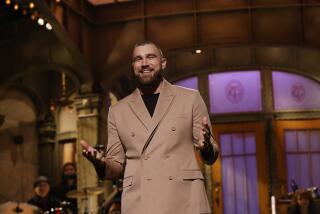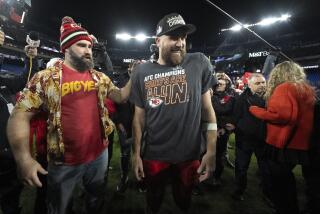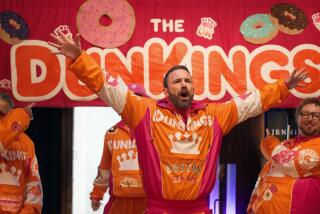RETROSPECTIVE
For years, John Elway played quarterback with more bravado than intelligence. Impatient and daring--a risky combination at a position where calmness is a required attribute--he frequently made ill-fated decisions rooted in a desire to produce the spectacular rather than settle for the effectively mundane. If he had finished his career caught in this rut, we would remember him as the most entertaining rascal ever to masquerade as a quarterback. But now he leaves with the circle so much more complete.
Thank goodness he smartened up these last few seasons. Finally relying on brains instead of strictly on brawn, he ended his career with the brilliance that now vaults him among the all-time greats who have ever filled the position. He no longer merely was an entertainer who won more games than any quarterback in history. He finished as a well-rounded practitioner who, to the end, still delighted and enthralled us with his mischief, who created smiles from the sheer joy of watching him pull off the seemingly impossible with routine predictability. And in the process, he clearly stuffed his own contention of years past that he didnât need Super Bowl victories to cap off his NFL accomplishments.
In the rush to praise him, it is easy to forget that, until the climax of the 1997 season, Dan Marino, not Elway, was considered the valedictorian of the quarterback class of 1983. Until then, neither had won an NFL championship, but the nod went to Marino for playing the position in a purer, more productive fashion. If you faced them, you feared Elway for his prodigious athleticism and fourth-quarter heroics. But you feared Marino more because of his ability to methodically carve up defenses from the very first possession. Marino, not Elway, was more consistently dangerous.
Yet Elway stayed around long enough to become a more reliable, precise, accurate quarterback--and, ultimately, more revered than his friend Dan, still without a ring. He stayed around long enough to reap the benefits of a running game and of having a friendly voice as his head coach. He stayed long enough to put not one but two exclamation points on any description of his career. But he is not staying around long enough to risk damage to everything he has worked so hard to accomplish.
That, too, is a reflection of his late-blooming smarts.
For all this talk of three consecutive Super Bowl victories and a special niche in history, Elway saw another side. I sat with him two years ago at training camp in Greeley, Colo., a cow-processing town in the northern part of the state where the air is filled every day with an overpowering smell of manure. âIf I could play without training camp, I might go on forever,â he said. âItâs spending your summer here that kills you. Youâre stuck in a dorm room, away from your family, and you are pushing yourself to get into shape. This is the part that is really unappealing to me.â
At 38, Elway is approaching middle age playing a kidâs game. A father of four, he found himself isolated too much from a family existence he wanted to relish and enjoy, lest he look back and realize how many days he missed witnessing his childrenâs accomplishments--and setbacks. His body reinforced the notion that it was time to get out. For the last two seasons, it has been payback time for years of recklessness. A bad throwing arm, gimpy ribs, a sore back, an ailing leg--they all conspired at times to sideline an athlete who rarely had missed any games despite being sacked more than any quarterback in history. A weekly massage became as important as studying the playbook.
To see him still scamper on the field, this huge man fearlessly romping for yards when discretion seemed a more fitting decision, you forget he is old. But his face, that former California blond visage of toothy smile and glowing eyes, has betrayed him. Wrinkles form under those eyes now, and a hint of gray dots the hair, and when he walks, especially deep into the season, he hobbles as much as saunters.
There was an ever-increasing health risk to come back for another season. And, just as important, he didnât need another Super Bowl win to add to his legacy. Instead, he is following a most pleasant trend in sports: great players, such as Michael Jordan and Wayne Gretzky--being smart enough to get out before they wished they had.
In a roll call of the five best who have played the position, it would be difficult now--unlike three years ago--to leave him out. Beyond that, his striking way of doing his job carves out for him a uniqueness that likely will never be duplicated. He is not the only quarterback, for example, who made a living off fourth-quarter comebacks; Marino, Unitas and Joe Montana certainly flourished under similar circumstances. But it was the manner in which he pulled off his intrepid adventures that weâll never forget.
It wasnât his style to stay calmly in the pocket and rely solely on his arm. That is not what we expected from him when the heat was on--and he rarely let us down. There would be harebrained scrambles that left us breathless and across-the-body, on-the-move, into-coverage bullets that should never been thrown, much less wind up as receptions. Heâd drop back, maybe scan his options for a millisecond and then off he would move, absorbing time, seeing targets that only gifted players like him can detect, audacious enough to unleash passes that only elite athletes like him would consider safe ventures.
God, it was great theater. And my God, how other teams grew to dread him and dislike his cockiness--and respect him without disclaimer. âYouâd be on the sideline and he would have the ball and you felt as hopeless as you possibly could,â says Ozzie Newsome, the Hall of Fame tight end who witnessed firsthand Elwayâs signature comeback, The Drive.
âItâs the improvisation that comes from being the competitor in me,â Elway said about his ad-libs. âItâs not wanting to give up on a play and even though it doesnât look good, trying to figure out a way to make something happen. Over time, you learn whenâs the right time and whenâs the wrong time and you try to eliminate the bad plays that you do make, trying to make the good plays. The chances Iâve taken, those have been outweighed by the plays that have been made.â
Forty-seven times, he saved the Broncos from defeat with fourth-quarter comebacks. No quarterback can duplicate that number. It happened to Marty Schottenheimer nine times alone, including The Drive, that 98-yard masterpiece on the mud of Cleveland Stadium that propelled the Broncos into their first Super Bowl under Elway. You would think Schottenheimer would never want to discuss this nemesis. But over the years, playing him twice a season in the AFC West, Schottenheimer has developed a deep and lasting respect for Elway.
âWith John, you come to respect his consistency and his desire,â Schottenheimer said in November. âI really do enjoy watching him play, even if he has killed us so many times. As a coach, you admire any athlete with that type of competitive spirit. Youâd like every player to be the same as him. I just wish that sometimes he played for another team. Maybe we would have won some more games if he had.â
For all his spectacular nuggets, Elway was viewed as a novelty act under the guidance of coach Dan Reeves. The two fussed and feuded and somehow pushed the Broncos into three Super Bowls, each one an embarrassment to the franchise and city. Elway was mediocre in all three losses, but in fairness to him, his team never had a chance in any of the matchups. He remained as close to a one-man gang as the NFL could boast, a tag that might be individually flattering but one he certainly wanted to shed. The Super Bowl failures tarnished his accomplishments and reduced his place in history. He disagreed with the critics, but ask him now if he doesnât think his career is viewed differently, two Super Bowl rings later.
Under Mike Shanahan, he flourished in a more complete way. âIf I had the coaching for my entire career that I had over the last four years, my numbers would be a lot different,â Elway says about the Shanahan seasons, where his touchdown-to-interception ratio (101/49) became one of legends and he learned the discipline and decisiveness that separate the complete quarterback from the physically blessed pretenders. Elway considered Shanahan, his old quarterback coach and offensive coordinator, to be a friend, not a verbal sparring partner, as had been the case with Reeves. Shanahanâs coaching philosophies brought direction and depth to Elwayâs performances; Shanahanâs presence brought a serenity to a career that he considered ending early to stop the internal turmoil created by his friction with Reeves. Instead, his last four seasons were the best run of his career.
Add in Terrell Davisâ running and Elway, now the thinking manâs quarterback, could enter championship games knowing, for a change, his arms and legs alone would not be the Broncosâ only advantage. In Super Bowl XXXII, Elway was part of the supporting cast to Davisâ main act, yet a stereotypical eight-yard scramble in the third quarter, when the Broncos desperately needed a first down, may be remembered now as the most important run of his career.
Smartly, he came back for one more season, and that gave him a chance to exit with not only another title but also with a more memorable performance. This was vintage new Elway against the Falcons in Super Bowl 33: 18-of-29, 336 yards and one wonderful 80-yard touchdown pass, a 3-yard touchdown run, an overwhelming command of the offense, a presence on the field that few before him have displayed. He wouldnât commit to retirement, but it seemed inevitable, so even then we compared his closing act to what Jordan produced in his final NBA game. With his only Super Bowl MVP trophy added to his accomplishments, he now becomes the rare quarterback to retire after winning the championship. Why push the envelope any further?
âI really do enjoy watching him play, even if he has killed us so many times. As a coach, you admire any athlete with that type of competitive spirit.
More to Read
Go beyond the scoreboard
Get the latest on L.A.'s teams in the daily Sports Report newsletter.
You may occasionally receive promotional content from the Los Angeles Times.










